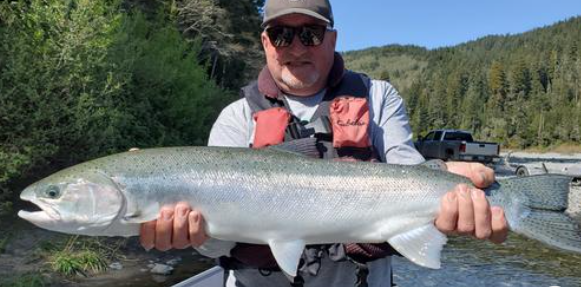By KENNY PRIEST
EUREKA — With very little rain falling throughout our region from January to March, most of us were already preparing for summer. However, the April showers hitting the coast are providing a second winter. These rains will definitely impact the health of future salmon and steelhead runs, which will likely be stronger a few years down the road because of it.
First off, the late winter and spring rains will benefit the next run of adult fish moving upriver, mainly spring salmon and summer steelhead. It may also increase the survival rates for recently spawned adult steelhead, or kelts, as well as salmon and steelhead fry and smolts that are all making their way downstream to the estuaries and ocean.
The high, muddy water allows the fish to make their way downriver with less risk of predation. The lack of fishing pressure will also help the kelts make their way back downriver successfully. Heavy spring rains should, in many cases, also result in higher flows and improved water quality later in the summer.
In most cases, the high flows also contribute to the health and complexity of the river’s estuary. A nutrient-rich estuary offers the young fish ample sources of food, allowing them to grow to an optimal size before entering the ocean. This greatly increases their chances of survival. A healthy estuary is also beneficial for the kelts, weak from their spawning journey, offering a safe haven for them prior to making their way back to the ocean.
With nature, it seems for every upside, there’s also a downside. In the event of extremely high late-winter and spring flows, problems can also occur for fish. Without adequate freshwater and estuarine slack water habitat, the young fish can get washed downstream before they’re ready, putting them in harm’s way.
Extremely high late-winter and early spring flows can also have a negative impact on late-spawning fish. Spawning areas known as “redds” can be scoured or the gravels within redds can be buried in fine sediment, preventing the young from emerging. After a few months of unseasonably dry weather, it’s a blessing to see the rivers running high and dirty. Hopefully our “second winter” will pay dividends in the future.
The Smith River was in perfect shape this weekend, but fishing pressure was light. Most of the steelhead have made their way back downriver, but there could be a few fresh ones around. Flows were right around 5,700 cfs at Jed Smith on Sunday with water color being a perfect shade of emerald green. The main stem of the Smith will remain open through the end of April from its mouth to the confluence with the Middle and South Forks.
The Middle Fork will also remain open through April from its mouth to Patrick’s Creek. The South Fork is open through April as well, from its mouth upstream approximately 1,000 feet to the County Road (George Tryon) bridge and Craig’s Creek to Jones Creek.
The Klamath River peaked at nearly 3,300 cfs Friday between the rain and water being let out from Iron Gate, but the river is now on the drop and turning green. Most of the steelhead have made their way down after spawning, but here should still be some coming from the Trinity. Springer season on the lower Klamath opens July 1.
In the Klamath tributary of the Trinity, the lows are starting to level off on the lower Trinity following the rain and releases from the dam. Fishing conditions weren’t good over the weekend, but they’ll continue to improve this week. The excess water increased the chances of the fry and spawners navigating their way safely downriver. As of Sunday, flows were 7,700 cfs on the Hoopa gauge.
In the main stem of the Eel River, after peaking at nearly 28,000 cubic feet per second Thursday, the main is big and brown but on the drop. With a dry week ahead, it could be fishable by the weekend. There should be some downers around and possible some fresh steelhead too. The main stem Eel to the South Fork is open all year. Only artificial lures with barbless hooks may be used from April 1 through Sept. 30.
Reminder: The South Fork Eel, Van Duzen, Mattole, Mad, Redwood Creek and the Chetco rivers are all closed to fishing.




